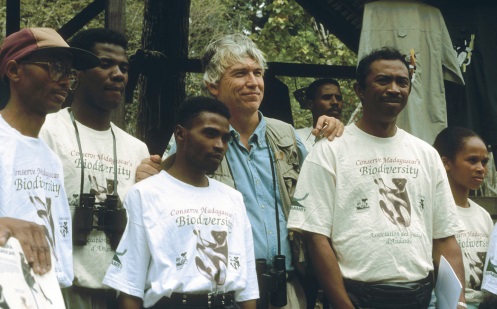Here we present a draft text for the "Ground rules and ethical considerations for primate-watching and primate life-listing." Any comments would be appreciated via Russell A. Mittermeier's primate tourism Twitter account - @PrimateTourism

Tourist guide association at Andasibe, Madagascar
GROUND RULES FOR PRIMATE-WATCHING AND PRIMATE LIFE-LISTING
1. Only species seen in the wild in Nature, can be counted, not species seen in captivity. You are free to make your own list of species seen in captivity as well, but they don’t count towards your Primate Life List.
2. Species in the wild can be counted under a number of conditions:
- · You locate the species on your own
- · You are shown the species by a guide or colleague
- · You find the animal using radio-telemetry (yes, this does count!)
- · You use recorded playback to locate the animal
- · You locate the animals at a site through provisioning (yes, this also counts, but we don’t encourage it)
3. A “natural habitat” can defined in a number of ways. Most primates occur naturally in forests, but several live in savannas and grasslands and often these develop a close association with human communities, raiding crops, begging for or stealing food, and even living permanently in urban areas. All of these “natural” habitats count.
4. Species seen under the following conditions cannot be counted:
- · Animals photographed by a camera trap, but not actually seen by you
- · Animals trapped either for research or by hunters
- · Animals shot for food while you are in the field
- · Animals killed on the road or under other circumstances
5. Species reintroduced into an area of natural habitat from which they were once extirpated count on your list. Species introduced to a habitat in which they did not naturally occur cannot be counted on your life list (e.g., green monkeys, mona monkeys, and rhesus macaques in the Caribbean, crab-eating macaques on Mauritius, squirrel monkeys in the Everglades). However, those that are of long-standing are of interest and are worthy of a special sub-list.
6. Only those species that are actually seen count towards your list. Vocalizations alone without eye contact are not sufficient. Here we go beyond the bird-watchers, many of whom count vocalizations.
7. Primate life-listing is on an Honor System. If you cheat and claim to see a species that you didn’t actually see, you are only cheating yourself. This works for the bird-watchers, it should work for us.
ETHICS OF PRIMATE-WATCHING AND PRIMATE LIFE-LISTING
1. Your actions in finding a primate species in the wild should not jeopardize its survival in any way. Respect the animals that you are observing and take away only photographs and memories.
2. Avoid transmitting human diseases to the primates you are observing, especially the great apes, and do not go out looking for them if you are ill.
3. Respect the field researchers who are studying the animals that you want to see. Often they will be your best guides, but sometimes their research requires that you stay away.
4. Respect the local communities living around key primate sites, help them to recognize the value of their primates and the habitats in which they occur, and employ them as much as possible. Even if you bring an outside expat guide, hire a local guide to join you as well. Remember that the future of primates and their habitats depends more than anything else on the attitudes and behavior of local people.
Best Practice Guidelines for the Conservation of Great Apes
A series of publications to address cutting-edge issues in great ape conservation provide guidance not only to great ape scientists and researchers in the field, but also to development organisations, donors, and governments involved in projects concerning great apes. The series editor is Liz Williamson, PSG Vice Chair for the Section on Great Apes (SGA). One of these guidelines concerns great ape tourism, available in English, French and Bahasa.
 Macfie, E.J. & Williamson, E.A. (2010). Best Practice Guidelines for Great Ape Tourism. IUCN/SSC Primate Specialist Group, Gland, Switzerland.
Macfie, E.J. & Williamson, E.A. (2010). Best Practice Guidelines for Great Ape Tourism. IUCN/SSC Primate Specialist Group, Gland, Switzerland.
Macfie, E.J. et Williamson, E.A. (2010). Lignes directrices pour de meilleures pratiques en matière de tourisme de vision des grands singes. Groupe de spécialistes des primates de la CSE/UICN, Gland, Suisse. 85 pp.
Macfie, E.J. dan Williamson, E.A. (2010). Panduan Wisata Kera Besar. IUCN/SSC Primate Specialist Group, Gland, Switzerland. 86 pp.


